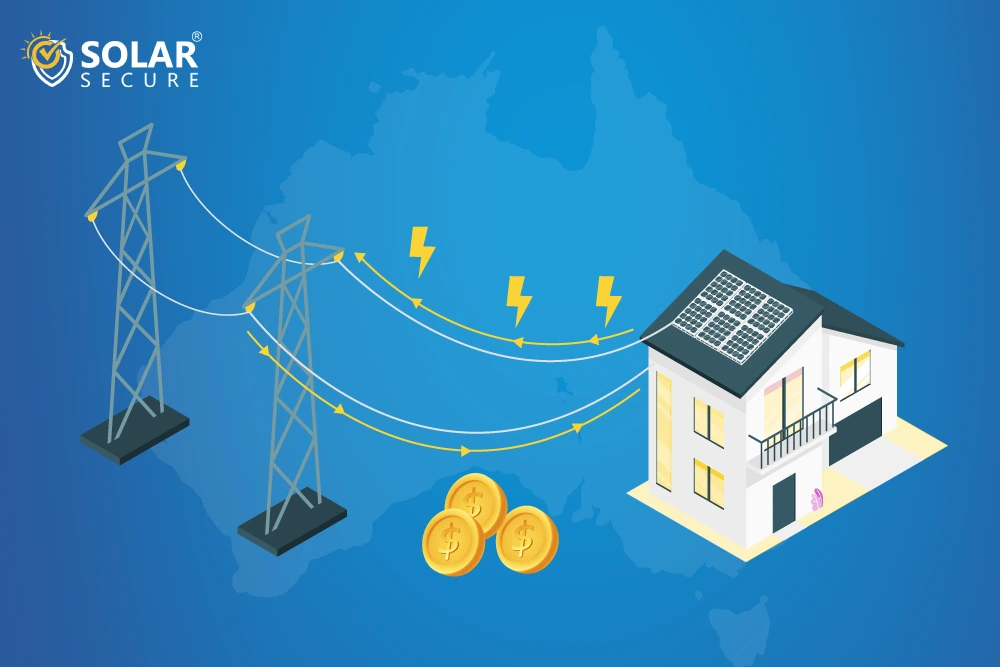Solar feed-in tariffs are agreements where owners of solar systems are compensated for the excess electricity they export to the grid. In the past, feed-in tariffs were compulsory across all Australian states, and the payments offered were quite generous.
Today, state-mandated feed-in tariff programs are no longer available to new solar customers in most parts of Australia. Instead, electricity retailers now offer feed-in rates voluntarily, typically ranging between 6 and 15 cents per kilowatt-hour, generally lower than the cost of buying electricity from the grid. Customers who enrolled before the deadlines of previous programs can continue receiving the agreed rates for the length of their contracts.
Because feed-in tariffs are no longer guaranteed by the government in many areas, solar owners need to compare offers from different retailers to secure the best available rates.
Why feed-in tariffs shouldn’t be your only consideration
While everyone aims to maximize the value of their solar investment, feed-in tariff rates are just one part of the equation.
A few years ago, feed-in tariffs played a major role in determining whether going solar was financially worthwhile in Australia. However, with the significant drop in solar PV system prices since then, investing in solar remains a smart choice, though the strategy for getting the most out of a system has shifted.
Back when feed-in tariffs were higher than the cost of electricity from the grid, it made sense for households and businesses to export as much of their solar energy as possible to maximize returns.
The Change towards maximizing solar energy usage at home
Today, the situation has reversed: to maximise the return on a solar investment, owners are best served by using as much of their generated electricity as possible, a strategy known as solar self-consumption. This approach is financially advantageous because every unit of solar energy used directly reduces the need to buy grid electricity, which typically costs between 20–30¢ per kilowatt-hour depending on the retailer and location. In contrast, exporting excess solar energy only earns around 6–10¢ per kilowatt-hour as credits on the electricity bill.
Clearly, the shift toward self-consumption is now a core factor in the economic case for going solar in Australia. This article aims to help solar buyers stay informed about the value of their exported solar energy so they can maximise the benefits of their system.
Australian Feed-in Tariffs by State and Electricity Retailer :
NSW Feed-in-Tariffs
Top 3 feed-in tariff NSW
| Top 3 Solar feed-in tariff rates in NSW | ||
|---|---|---|
| RETAILERS | MIN SOLAR FiT | MAX SOLAR FiT |
| Ampol Energy | 7.0c | 7.0c |
| Engie | 5.5c | 12c (for the first 8kWh/day, 5.5c thereafter) |
| CovaU Energy | 5.5c | 5.5c |
Feed-in tariff for major NSW retailers
| Solar feed in tariff rates for major NSW retailers | ||
|---|---|---|
| NSW MAJOR RETAILERS | MIN SOLAR FiT | MAX SOLAR FiT |
| 1st Energy | 1.5c | 5.0c (for the first 15kWh/day 2.5c thereafter) |
| AGL | 5.0c | 10c (for the first 10kWh/day, 5c/kWh thereafter) |
| Alinta Energy | 5.0c | 10c (for the first 10kWh/day, 5c/kWh thereafter) |
| Amber Electric | 0C | 0c (estimated based on wholesale prices) |
| Diamond Energy | 5.2c | 5.2c |
| Dodo | 3.5c | 3.5c |
| EnergyAustralia | 5c | 10c (for the first 12kWh/day, 5c thereafter) |
| Momentum Energy | 5.0c | 5.0c |
| Origin Energy | 5c | 8c (for the first 8kWh/day, 5c thereafter) |
| OVO Energy | 3.0c | 3.0c |
| Powershop | 1.4c | 1.4c |
| Red Energy | 1.4c | 10c (for the first 5kWh/day, 5c thereafter) |
| Sumo | 1.0c | 8.1c |
VIC Feed-in-Tariffs
Top 3 Feed-in Tariff VIC
| Top 3 Feed-in Tariff rates VIC | ||
|---|---|---|
| RETAILERS | MIN SOLAR FiT | MAX SOLAR FiT |
| Diamond Energy | 5.2c | 5.2c |
| CovaU Energy | 4.9c | 4.9c |
| Arcline by RACV | 4.1c | 4.1c |
Feed-in tariff for major VIC retailers
| Solar feed in tariff rates for major VIC retailers | ||
|---|---|---|
| VIC MAJOR RETAILERS | MIN SOLAR FiT | MAX SOLAR FiT |
| 1st Energy | 3.3c | 3.3c |
| AGL | 3.3c | 3.3c |
| Alinta Energy | 3.3c | 10c (for the first 10kWh/day, 3.3c/kWh thereafter) |
| EnergyAustralia | 3.3c | 12c (for the first 10kWh/day, 3.3c thereafter) |
| Energy Locals | 3.3c | 5c (for the first 8kWh/day, 3c thereafter) |
| Engie | 3.3c | 12c |
| 12c | 2.1c | 2.1c |
| Lumo Energy | 3.3c | 4.5c |
| Momentum Energy | 3.3c | 6.0c |
| Origin | 3.3c | 5c (for the first kWh/day, 3.3c thereafter) |
| Powershop | 3.3c | 3.7c |
| Red EnergyAGL | 3.3c | 4.5c |
| Sumo | 3.3c | 3.3c |
| Tango | 3.3c | 3.3c |
QLD Feed-in-Tariffs
Top 4 feed-in tariff rates QLD
| TOP SOLAR FEED IN TARIFF IN QLD | ||
|---|---|---|
| RETAILERS | MIN SOLAR FiT | MAX SOLAR FiT |
| Engie | 5.5c | 12c (for the first 8kWh/day, 5.5c thereafter) |
| Energy Locals | 7.0c | 7c (for the first 8kWh/day, 8c thereafter) |
| EnergyAustralia | 4.6c | 10c (for the first 12kWh/day, 4.6c thereafter) |
| AGL | 4.0c | 10c (for the first 10kWh/day, 4c/kWh thereafter) |
Feed-in Tariff for major QLD retailers
| FEED-IN TARIFF FOR MAJOR QLD RETAILERS | ||
|---|---|---|
| QLD MAJOR RETAILERS | MIN SOLAR FiT | MAX SOLAR FiT |
| Dodo | 3.5c | 3.5c |
| Energy Locals | 7.0c | 7c (for the first 8kWh/day, 8c thereafter) |
| GloBird Energy | 1.0c | 11c (for the first 8kWh/day, 3c thereafter) |
| Momentum Energy | 2.9c | 4c |
| OVO Energy | 3.0c | 3.0c |
| Origin Energy | 4.0c | 8c (for the first 8kWh/day, 4c thereafter) |
| Powershop | 1.4c | 1.4c |
| Red Energy | 1.0c | 8.0c |
| 1st Energy | 1st Energy | 5.0c (for the first 15kWh/day, 2.5c thereafter) |
SA Feed-in-Tariffs
No minimum Feed-in Tariff is mandated in South Australia. Retailers offer different rates to solar PV system owners, which may change over time depending on the wholesale energy market and competitive pressures.
Top 3 Feed-in Tariff SA
| TOP 3 FEED-IN TARIFF SA | ||
|---|---|---|
| RETAILERS | MIN SOLAR FiT | MAX SOLAR FiT |
| CovaU Energy | 5.5c | 5.5c |
| Diamond Energy | 5.2c | 5.2c |
| EnergyAustralia | EnergyAustralia | 10c (for the first 12kWh/day, 4.5c thereafter) |
Feed-in Tariff for major SA retailers
| FEED-IN TARIFF FOR MAJOR SA RETAILERS | ||
|---|---|---|
| SA MAJOR RETAILERS | MIN SOLAR FiT | MAX SOLAR FiT |
| 1st Energy | 1.5c | 1.5c |
| AGL | 4.0c | 10c (for the first 10kWh/day, 4c/kWh thereafter) |
| Alinta Energy | 4.0c | 10c (for the first 10kWh/day, 4c/kWh thereafter) |
| Dodo | 3.5c | 3.5c |
| Energy Locals | 1.0c | 6c (for the first 8kWh/day, 2c thereafter |
| Engie | 4.2c | 11c (for the first 8kWh/day, 4c thereafter) |
| GloBird Energy | 1.0c | 1.5c |
| Lumo Energy | 3.0c | 4.5c |
| Momentum Energy | 2.5c | 2.5c |
| OVO Energy | 2.0c | 2.0c |
| Powershop | 1.4c | 1.4c |
| Red Energy | 3.0c | 4.5c |
| Sumo | 1.0c | 1.0c |
WA Feed-in-Tariffs
Western Australia’s DEBS program pays eligible solar PV systems, batteries, and EVs for the electricity they export to the grid.
The scheme features time-dependent rates, with higher compensation during late afternoon and evening periods to align with peak demand and elevated wholesale electricity prices.
| DEBS rates for Synergy customers 2025 | ||
|---|---|---|
| PEAK | TIME PERIOD | EARNS c/kWh |
| Peak rates | Peak rates | 10.0c |
| Off-peak rates | Electricity is exported between 9pm and 3pm | 2.0c |
ACT Feed-in-Tariffs
Since the ACT government's feed-in tariff scheme stopped accepting new applications in 2011, feed-in tariffs are no longer government-regulated and are instead determined by retailers. Until recently, strict state regulations meant that only a small number of electricity retailers were willing to operate in the ACT, limiting customer choices. However, more retailers have now entered the market, giving customers the opportunity to explore better deals.
Top 3 Feed-in Tariff ACT
| TOP 3 FEED-IN TARIFF ACT | ||
|---|---|---|
| RETAILERS | MIN SOALR FiT | MAX SOALR FiT |
| Origin Energy | 9.0c | 10c (for the first 8kWh/day, 9c thereafter) |
| Nectr | 8.94c | 8.94c |
| ActewAGL | 8.0c | 8.0c |
Feed-in Tariff for major ACT retailers
| FEED-IN TARIFF FOR MAJOR ACT RETAILERS | ||
|---|---|---|
| ACT MAJOR RETAILERS | MIN SOALR FiT | MAX SOALR FiT |
| Energy Locals | 7c (for the first 8kWh/day, 3c thereafter) | 7c (for the first 8kWh/day, 3c thereafter) |
| CovaU Energy | 5.5c | 5.5c |
| 5.5c | 5.0c | 10c (for the first 12kWh/day, 5c thereafter) |
| Red Energy | 5.0c | 5.0c |
| Amber Electric | 0c (estimated based on wholesale prices) | 0c (estimated based on wholesale prices) |
Conclusion
We hope this has helped you better understand how to select an electricity retailer that aligns with your needs. As noted earlier, don't base your decision solely on the highest feed-in tariff.
Be sure to consider other elements like the payback period, supply and usage rates, and even non-financial aspects like the quality of customer service.





